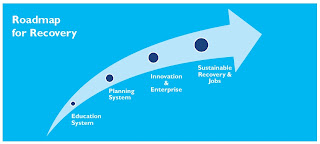I was invited by the Department of the Environment Community and Local Government 'Market Development Group rx3' to the launch of the first national compost standard by the Minister Phil Hogan TD and the Chief Executive of the National Standards Authority of Ireland (NSAI) Maurice Buckley Chartered Engineer.
'rx3 - Rethink Recycle Remake' was set up by the Dept of the Environment, Heritage and Local Government in 2008 to increase recycling in Ireland and to create new products and sustainable employment at home instead of exporting to Europe and Asia . The programme is for 5 years and is currently in mid cycle. The three waste materials under research focus are Paper, Plastics and Organics. Paper and Plastics are generally exported for recycling but a substantial quantity is still landfilled until better recycling infrastructure is developed in Ireland. Organic or food waste is either composted or disposed to landfill in Ireland.
Under the EU Landfill Directive sending organic or food waste to landfill is increasingly unacceptable so 'rx3' is developing alternative products and markets in Ireland for different specification composts including golf courses, public parks, playing pitches and roadside grass verges. Crop trials are currently ongoing in the soils of different counties to confirm what compost qualities work best in different soil types.
We were launching the first Irish Standard for Compost Quality - IS 441 setting out the preference for source separation of organic waste to prevent cross contamination so that a quality compost is guaranteed and can compete with Bord na Mona and other home produced composts.
The recycling of food and garden waste into a high quality compost is important as biodegradable material (paper and food/garden waste) makes up some 60% of the normal household bin. Paper and other dry recyclables are collected in the green bin while food and other 'wet' waste is collected in the brown bin. The contents of both bins should go to recycling and the remaining black bin residual waste should be used for energy recovery in preference to landfill as the last resort.
The Minister has published a very sustainable new Draft Waste Policy which we hope to see adopted by year end so that maximum waste recycling and energy recovery can proceed in order to minimise the landfill of waste. This new policy will build on the success of the current national waste policy 'Changing Our Ways' published in 1998 which led to municipal waste recycling rising from 8% to some 38% over the past ten years through the steady implementation of the regional waste management plans.
Unfortunately there was stagnation in waste policy implementation over the period 2007 to 2011 which led to lack of investment in waste infrastructure and from which it will take Ireland
 |
| Conor McGovern Manager rx3, Olivier Gaillot Project Manager rx3, Maurice Buckley Chief Executive of NSAI, Minister Phil Hogan TD and PJ Rudden President of Engineers Ireland , |









.jpg?uid=1277450602204)





